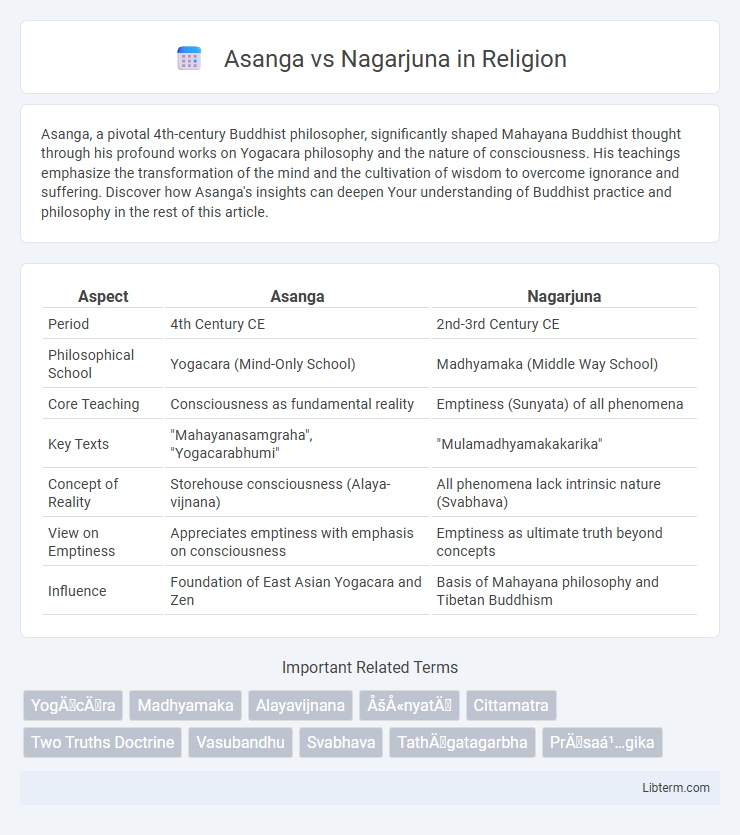Asanga, a pivotal 4th-century Buddhist philosopher, significantly shaped Mahayana Buddhist thought through his profound works on Yogacara philosophy and the nature of consciousness. His teachings emphasize the transformation of the mind and the cultivation of wisdom to overcome ignorance and suffering. Discover how Asanga's insights can deepen Your understanding of Buddhist practice and philosophy in the rest of this article.
Table of Comparison
| Aspect | Asanga | Nagarjuna |
|---|---|---|
| Period | 4th Century CE | 2nd-3rd Century CE |
| Philosophical School | Yogacara (Mind-Only School) | Madhyamaka (Middle Way School) |
| Core Teaching | Consciousness as fundamental reality | Emptiness (Sunyata) of all phenomena |
| Key Texts | "Mahayanasamgraha", "Yogacarabhumi" | "Mulamadhyamakakarika" |
| Concept of Reality | Storehouse consciousness (Alaya-vijnana) | All phenomena lack intrinsic nature (Svabhava) |
| View on Emptiness | Appreciates emptiness with emphasis on consciousness | Emptiness as ultimate truth beyond concepts |
| Influence | Foundation of East Asian Yogacara and Zen | Basis of Mahayana philosophy and Tibetan Buddhism |
Introduction to Asanga and Nagarjuna
Asanga, a key figure in Mahayana Buddhism, is renowned for founding the Yogachara school, emphasizing the nature of consciousness and the concept of "mind-only" (Cittamatra). Nagarjuna, the founder of the Madhyamaka school, introduced the philosophy of emptiness (Shunyata), which challenges inherent existence and advocates for the Middle Way. Their contrasting teachings form the foundational dialectic in Buddhist philosophy, with Asanga focusing on the analysis of consciousness and Nagarjuna on the nature of reality and emptiness.
Historical Context and Philosophical Background
Asanga and Nagarjuna were key figures in Mahayana Buddhism during the 2nd and 3rd centuries CE, shaping its doctrinal foundations amid evolving philosophical debates in ancient India. Nagarjuna is renowned for developing the Madhyamaka school, emphasizing the concept of sunyata (emptiness) to dismantle inherent existence in all phenomena. Asanga, associated with the Yogacara school, advanced idealist interpretations focusing on consciousness (vijnapti-matra) and the role of mental constructs in perceiving reality.
Core Teachings of Asanga: Yogacara School
Asanga, a key figure in the Yogacara school, emphasized the doctrine of "storehouse consciousness" (alaya-vijnana) as the foundation of all experiences, contrasting Nagarjuna's focus on emptiness (shunyata). Asanga taught that consciousness shapes reality through eight types of mind, where perceptions and karmic seeds reside and mature, forming the basis of samsara and nirvana. His core teachings advocate the transformation of consciousness by cultivating wisdom and compassion to realize the non-dual nature of existence.
Nagarjuna’s Madhyamaka Philosophy Explained
Nagarjuna's Madhyamaka philosophy centers on the concept of sunyata, or emptiness, asserting that all phenomena lack inherent existence and arise dependently through causes and conditions. He employs rigorous dialectical reasoning to deconstruct essentialist notions, demonstrating that phenomena neither exist independently nor are completely non-existent. This middle way avoids the extremes of eternalism and nihilism, serving as a foundation for Mahayana Buddhist thought and practice.
The Nature of Reality: Yogacara vs. Madhyamaka
Asanga, a key proponent of Yogacara, emphasizes consciousness-only (vijnaptimatra) as the fundamental nature of reality, asserting that external objects have no independent existence apart from the mind. Nagarjuna, founder of Madhyamaka, asserts the doctrine of emptiness (shunyata), arguing that all phenomena are empty of inherent existence and exist only in dependence on causes and conditions. While Yogacara focuses on the nature of consciousness as the basis of reality, Madhyamaka deconstructs all conceptual fabrications, highlighting the inseparability of emptiness and dependent origination.
Concept of Emptiness: Divergence and Convergence
Asanga emphasizes the concept of emptiness (sunyata) primarily through the lens of Yogacara philosophy, interpreting it as the absence of inherent existence in external objects while affirming the existence of consciousness. Nagarjuna's Madhyamaka school, by contrast, asserts emptiness as the ultimate nature of all phenomena, rejecting intrinsic essence in both subject and object, thereby highlighting the dependence on causes and conditions (pratityasamutpada). Despite their divergence, both philosophers converge on the essential insight that emptiness dismantles inherent self-nature, serving as a crucial foundation for liberation from suffering in Mahayana Buddhism.
Methods of Practice and Meditation
Asanga's methods of practice emphasize the cultivation of profound concentration (samadhi) through the development of the mind's innate purity and the practice of compassion, utilizing Yogacara meditation techniques to transform perception into wisdom. Nagarjuna's approach centers on analytical meditation (vipasyana) to penetrate the emptiness (sunyata) of all phenomena, using logical reasoning and dialectical methods to deconstruct inherent existence and overcome conceptual grasping. While Asanga integrates visualization and mental training to realize Buddha-nature, Nagarjuna prioritizes rigorous philosophical inquiry to dissolve dualistic thinking and attain liberation.
Influence on Mahayana Buddhism
Asanga and Nagarjuna are pivotal figures whose philosophies profoundly shaped Mahayana Buddhism; Nagarjuna's development of Madhyamaka philosophy introduced the concept of emptiness (sunyata), challenging inherent existence and influencing Mahayana's metaphysical framework. Asanga, founder of the Yogacara school, emphasized the nature of consciousness and mind-only (cittamatra) doctrine, further enriching Mahayana's psychological and epistemological dimensions. Their combined contributions established foundational principles that continue to guide Mahayana practice, doctrinal interpretation, and scholastic discourse.
Modern Interpretations and Legacy
Modern interpretations of Asanga emphasize his role in developing the Yogacara school, highlighting his contributions to the understanding of consciousness and the mind. Nagarjuna is widely regarded for founding the Madhyamaka school, which profoundly influenced Buddhist philosophy through its doctrine of emptiness (sunyata). Both thinkers' legacies continue to shape contemporary Buddhist studies, with Nagarjuna's dialectical method and Asanga's cognitive theories integrated into modern philosophical and psychological discourse.
Conclusion: Comparative Significance
Asanga and Nagarjuna hold pivotal roles in Buddhist philosophy, with Nagarjuna's Madhyamaka emphasizing emptiness (sunyata) as the ultimate reality, while Asanga's Yogacara highlights consciousness-only (vijnaptimatra) as the foundation of experience. Nagarjuna's dialectical method profoundly influenced Mahayana thought by deconstructing inherent existence, whereas Asanga's systematic elaboration of mind and cognition advanced the understanding of phenomenological processes within Buddhism. Their complementary contributions forged a comprehensive framework integrating ontology and epistemology, shaping the evolution of Buddhist metaphysics and practice.
Asanga Infographic

 libterm.com
libterm.com